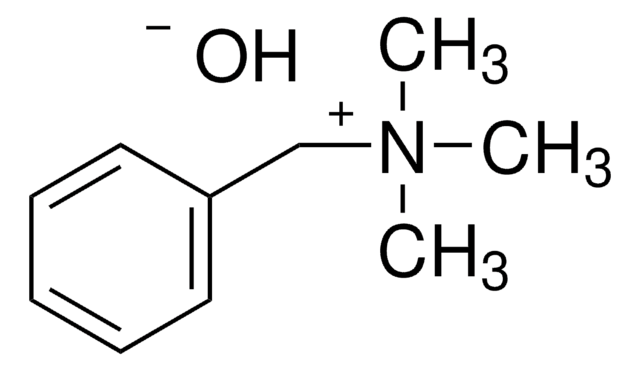79266
Trimethylphenylammonium hydroxide solution
~0.5 M (CH3)3N(OH)C6H5 in methanol, for GC derivatization, LiChropur™
Sinónimos:
Phenyltrimethylammonium hydroxide, TMAH
About This Item
Productos recomendados
grado
for GC derivatization
Nivel de calidad
Formulario
liquid
calidad
LiChropur™
idoneidad de la reacción
reagent type: derivatization reagent
reaction type: Esterifications
concentración
~0.5 M (CH3)3N(OH)C6H5 in methanol
técnicas
gas chromatography (GC): suitable
impurezas
≤0.2% halides (as chloride)
temp. de almacenamiento
2-8°C
cadena SMILES
[OH-].C[N+](C)(C)c1ccccc1
InChI
1S/C9H14N.H2O/c1-10(2,3)9-7-5-4-6-8-9;/h4-8H,1-3H3;1H2/q+1;/p-1
Clave InChI
HADKRTWCOYPCPH-UHFFFAOYSA-M
¿Está buscando productos similares? Visita Guía de comparación de productos
Categorías relacionadas
Descripción general
Aplicación
Otras notas
Información legal
Palabra de señalización
Danger
Frases de peligro
Clasificaciones de peligro
Acute Tox. 3 Dermal - Acute Tox. 3 Inhalation - Acute Tox. 3 Oral - Eye Dam. 1 - Flam. Liq. 2 - Skin Corr. 1B - STOT SE 1
Órganos de actuación
Eyes
Código de clase de almacenamiento
3 - Flammable liquids
Clase de riesgo para el agua (WGK)
WGK 3
Punto de inflamabilidad (°F)
51.8 °F - closed cup
Punto de inflamabilidad (°C)
11 °C - closed cup
Equipo de protección personal
Faceshields, Gloves, Goggles
Elija entre una de las versiones más recientes:
¿Ya tiene este producto?
Encuentre la documentación para los productos que ha comprado recientemente en la Biblioteca de documentos.
Los clientes también vieron
Nuestro equipo de científicos tiene experiencia en todas las áreas de investigación: Ciencias de la vida, Ciencia de los materiales, Síntesis química, Cromatografía, Analítica y muchas otras.
Póngase en contacto con el Servicio técnico

















